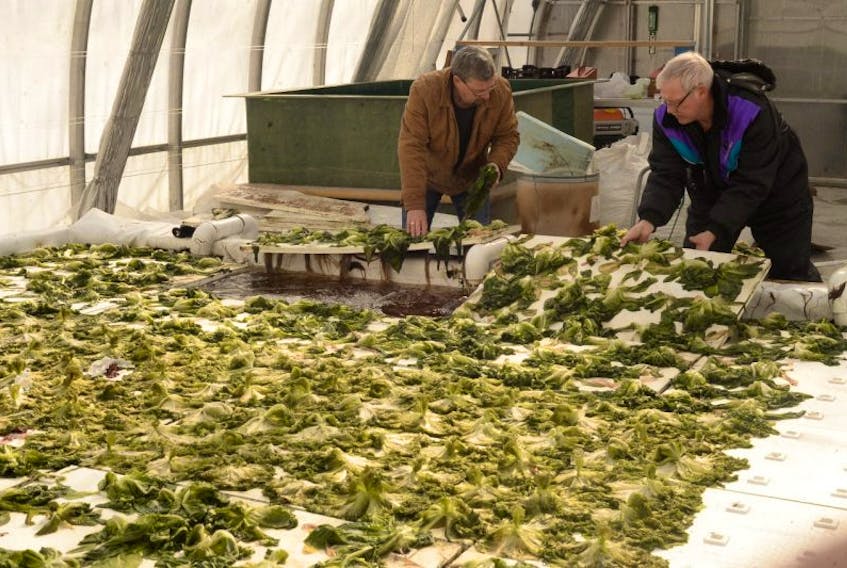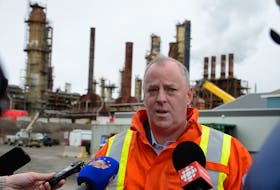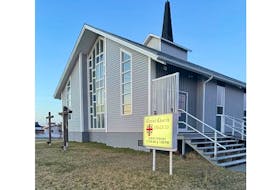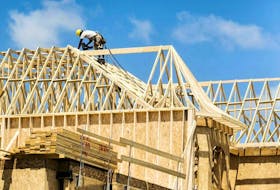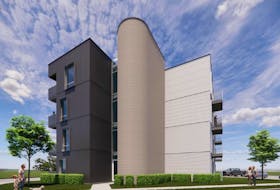Jim Lester said they clocked winds up to 160 kilometres per hour at the farm early Saturday afternoon.
Even so, the specialized plastic covering the aquaponics facility was withstanding the gusts up until it was hit by flying debris.
“The plastic was holding up fine because as long as the plastic is inflated and there are no tears in the plastic, it will hold together,” Lester said.
“Blowing debris cut about a six-foot strip in the top layer and within 10 minutes that six-foot strip turned into a 60-foot strip, which allowed an immense amount of wind pressure to build up within the facility. With the facility being winterized, we couldn’t raise the sides to let the pressure out. Then it just became too hazardous and everything exploded.”
In all, about 10,000 plants in the facility were lost.
Jim Lester said they clocked winds up to 160 kilometres per hour at the farm early Saturday afternoon.
Even so, the specialized plastic covering the aquaponics facility was withstanding the gusts up until it was hit by flying debris.
“The plastic was holding up fine because as long as the plastic is inflated and there are no tears in the plastic, it will hold together,” Lester said.
“Blowing debris cut about a six-foot strip in the top layer and within 10 minutes that six-foot strip turned into a 60-foot strip, which allowed an immense amount of wind pressure to build up within the facility. With the facility being winterized, we couldn’t raise the sides to let the pressure out. Then it just became too hazardous and everything exploded.”
In all, about 10,000 plants in the facility were lost.

Four other greenhouses on the farm lost their plastic coverings, too. Those greenhouses were empty at the time, but staff were getting ready to start planting perennial flowers and vegetables, and cool season vegetables. The plastic on those greenhouses is expected to be replaced sometime next week and the planting work will begin, about 10 days behind schedule.
In all, the damage — which is not insurable — and time delays will amount to about $100,000 for the farm, Lester said.
“Greenhouse operations in Newfoundland are subject to our environment, and there are only certain perils that they (insurance companies) will insure and wind damage is not one of them,” he said.
The biggest issue for the farm now is to get the aquaponics facility back in operation.
Aquaponics is a blend of hydroponic vegetable production (soil-less vegetable production) and aquaculture, usually growing talipia in tanks. Talipia is a warm, freshwater fish species grown in many aquaculture operations across Canada.

“Basically, what we do, we feed the talipia conventional fish feed, a vegetable-based fish feed, and what happens is the water from the talipia tanks is overflowing into a filter which removes all the solid waste,” Lester said.
“The water that passes through the filter is still loaded with nutrients the fish produce and it flows in and cycles through the plant bed. The roots of the plants hang down in the water and remove all the nutrients and ammonia that the fish produce.”
In turn, notes Lester, the plants — including various types of lettuce and culinary herbs — clean the water for the fish.
“This plant bed system is an intricate part of keeping our fish alive, as well,” he said.
“Anybody who has a fish tank at home, multiply that by about a million, then you can realize how important the filter is in this system. Without the plants we have no filter.”
Lester said the windstorm damage has made it difficult for the farm to stay on its all-important timelines for its products.
“The lettuces in this system we can have up and running in about four weeks time,” he said. “The herbs, a lot of them are continually harvested so we spent a lot of time building up a base, so you are looking at about eight to 10 weeks before we can get back there.”
The farm is already coming off a bad 2016, he noted, not because of any natural impediment, but because of lengthy work on Pearltown Road that prevented people from entering the farm area.
“We are coming off a bad year last year where the city had closed our road for basically the whole summer season to replace the bridge there, and they encountered some delays that turned a 45-day project into 120 days,” he said. “That really had an affect on the traffic to our farm.”
At the time of the wind damage, the Lesters had already been discussing placing a more permanent covering on the outside of the aquaponics facility, which supplies fresh produce year-round to customers.
“It is substantially more of a cost, but well-worth the investment when you consider all the hard work and resources we’ve put into this crop and maybe it could have been mitigated,” Lester said.
“You have to have farmer’s optimism and hope it’s not going to happen again, or if it does, you would have already put in place factors that may reduce the damage.”
Lester said he can’t recall a weather event that caused so much damage to the farm. There have been times when plastic was damaged or blew off greenhouses mainly because it was nearing its normal lifecycle and was weakened, but never so much damage at one time.
“I remember my grandfather telling me stories of years ago of how people’s barns and houses were lifted off their foundations and put in neighbouring fields,” he said.
“This is one of those stories I’ll recount to my grandchildren.”


